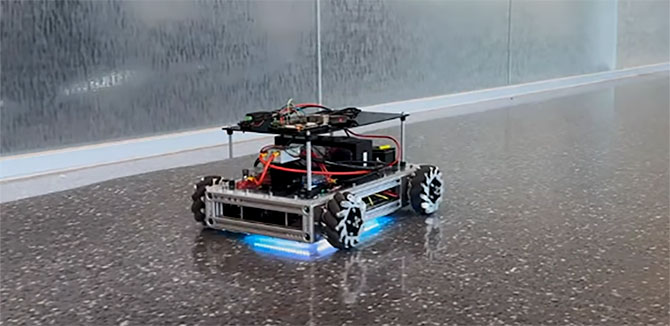MSR Students Show Off Work at Museum of Science and Industry
The annual event hosted by Chicago's Museum of Science and Industry allowed students working with robotics to interact with guests of all ages and technical savvy.

Maximiliano Palay (MSR '24) had never visited Chicago's Museum of Science and Industry, but he knew it was the largest science museum in the western hemisphere.
That was just one reason why he was excited to participate in the Museum's annual Robot Block Party, where he and his classmates displayed their work and inspired the imagination of museum guests.
"It's always a great exercise to present a very technical project to a non-technical audience," Palay said. "The amount of work that goes into each one of these projects is immense, so being able to summarize and keep to a few key points is challenging. Practice makes perfect, so I value every conversation I had."
Palay showed off Minimec, an omnidirectional vehicle that he designed, assembled, and programmed for his independent project. The vehicle relied on a mecanum wheel base and was created using off-the-shelf components, though Palay still spent more than 40 hours in the program's machine shop making parts for the robot.
In talking with museum guests, Palay focused on the potential impact of his project to explain its significance to a non-technical audience. While people might think of vehicles moving sideways as beneficial for trying to parallel park, Palay instead spoke of warehouse applications where confined spaces and movement restrictions matter.
The highlight for Palay was seeing how museum guests responded to his vehicle.
"The best part of it was seeing everyone's reactions when they realized the robot was moving sideways," he said. "It was a very fun time. People of all ages were constantly amazed and several approached me to talk about how this was possible."
Srikanth Schelbert (MSR '24) enjoyed that amazement as well.
"Most people don't interact with robots on a day-to-day basis, and even those with experience have a spectrum of knowledge," he said. "Giving the museum goers an opportunity to interact with our robots in a novel way and creating a tangible connection to their daily lives was a goal that I and the others had for the day."
Schelbert displayed two robotic projects at the Block Party. The first was a mobile robot that could autonomously distribute road salt on a walkway, and the second was an interactive "Hangman" game player he created with a group of classmates.
Schelbert's Saltbot was designed to map an outdoor space, automatically plan a path to cover the area, and then autonomously navigate through that path while distributing salt. The "Hangman" project would read a guest's writing and then administer the game. It was a great opportunity for Schelbert and his MSR classmates to show attendees what it is like to interact with a robot, he said.
One point Schelbert tried to stress with attendees was that technology can be intimidating from the outside, but a willingness to learn can lead to marked growth in a short time frame.
"I am constantly impressed with the amount of opportunities the MS in Robotics students at Northwestern are given," he said, "as well as how talented everyone becomes as the program progresses."

